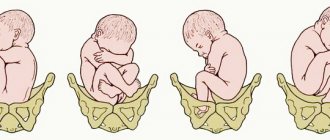Conversations about age standards are not uncommon for parents. Our competitive nature and cultural characteristics constantly encourage us to boast about new successes in the development of children and compare them with the results of our peers.
Almost all parents carefully monitor development calendars and lists of skills that children should master by a certain age. It's nice when the baby develops in accordance with them or even a little ahead, but the thought of possible developmental delays can make even the calmest parents nervous.
Children's Montessori has prepared a memo for parents, in which we will tell you what can be considered a real developmental delay, when there is no need to worry and, most importantly, what contributes to the harmonious development of the baby.
Five areas of child development
Child development can be viewed from five different perspectives:
Cognitive development
This includes all skills related to information processing: thinking, memory, attention. The ability to learn and understand this world primarily depends on these skills. The development of cognitive skills is about the ability to classify objects, count, name colors and shapes, identify patterns, etc.
Emotional and communication development
These include skills in interacting with others and the ability to express and control emotions. In infancy, the development of this area begins with smiling and humming in the presence of familiar people. Later, the development of communication and emotional skills includes the ability to make acquaintances with peers, express one’s feelings, be able to ask for help, etc.
Speech development
This includes all stages of development of language understanding and use. In infancy, this is humming and babbling; in older age, this is the ability to understand spoken speech and correctly use and pronounce words and sentences in one’s own speech.
Development of gross and fine motor skills
This includes mastery of one’s own body: fine motor skills primarily refer to the degree of development and control of the muscles of the hands and fingers, while gross motor skills refer to the control of the large muscles of the body, which affect the overall coordination and dexterity of the baby. The development of this skill begins from the first days of life, when the baby learns to grab objects with his hand, hold his head, roll over, crawl, etc. In adulthood, this includes the ability to use cutlery and writing instruments, make various crafts, as well as run, jump, and perform various gymnastic exercises.
Development of household skills
This category includes all self-care skills: the ability to eat, dress, shower and go to the toilet independently, organize a work space, etc.
For each of these categories there is an approximate list of skills for different ages. Here, for example, is a list of cognitive skills of a three-year-old:
- Knows the basic colors and can name them,
- Counts to 10
- Has an idea of the time of day (morning, afternoon, evening, night),
- Can remember and retell simple stories
- Can find simple similarities and differences between objects (e.g. big/small),
- Can follow simple instructions (eg, bring your shirt and put it in your cart).
Complete lists of skills for different ages can be found in other articles on our website or refer to the literature on child development (for example, “Child Development Calendar” by Elena Khramova).
Small differences in the time and order of acquisition of various skills should not bother parents in any way. For example, if the baby does not roll over by 4 months, but the rest of his condition does not bother the mother, then this phenomenon can be safely attributed to individual developmental characteristics and we can expect to master this skill in the near future. You should react completely differently if a baby of the same age not only does not roll over, but also does not hold his head well when lying on his back and stomach and does not hold objects in his hands.
Unlike difficulties with individual skills, which can be attributed to individual developmental characteristics, a whole complex of several skills that have not been mastered by a certain age can signal a delay in one or more areas of development.
When to sound the alarm?
- By the end of the first month of life, the child cannot independently hold his head for 20-30 seconds.
- At two months of age, he is unable to raise his head for a couple of minutes from a position lying on his tummy.
- By three months, the baby does not hold the rattle when it is placed in his hand, does not look at his hands, and does not clasp them together.
- At four months, the baby cannot change body position or roll over onto its side from its back.
- 5 months – holds his head unsteadily, cannot roll over from tummy to back.
- 6 months - the child does not take toys himself, does not transfer objects from one hand to another, does not move his legs if he is supported under the armpits.
- 7 months – does not attempt to sit up while holding mother’s hands.
- By the end of the 8th month, he is unable to crawl to an object of interest, cannot sit independently or stand with support.
- By the end of the 9th month of life, the child still sits unsteadily, cannot stand leaning on furniture/wall, does not crawl, and is not able to drink from a mug on his own.
- In one year, the baby does not take at least a few steps along the crib or sofa, does not squat, holding on to the furniture.
- At two years old he does not speak words, at three years old he speaks poorly, often falls when walking and is not interested in games.
If your child’s behavior and motor development differs from his peers, this is not a reason to panic. But this is a wake-up call. Each baby has its own physiological characteristics and genetics. However, if by a certain age he has not developed motor skills and motor skills, then he should immediately seek qualified help and begin a rehabilitation program as early and comprehensively as possible.
What you need to know about developmental delays?
Developmental delay is not just “being slightly behind” or “developing slower than peers.” This means that the child regularly fails to master skills typical for his age. Such a delay can manifest itself in one area or several at once.
Having learned that the child has a developmental delay, parents tend to blame themselves and the chosen method of upbringing for this, but in fact, we have almost no power to influence the reasons that cause developmental delays, but we can help the child overcome them
For example, delays in speech development do not occur due to bilingualism in the family or too early exposure to English classes. But temporary hearing loss (for example, due to severe otitis media) may well cause such disorders.
There are three main factors that scientists associate with childhood developmental delays:
- Difficulties at birth: prematurity, low birth weight and hypoxia at birth often cause developmental delays in the first years of life,
- Unfavorable environment: poisoning, poor nutrition of mother and child, parental drinking and smoking, unfavorable family atmosphere and injuries,
- Illnesses of the child: chronic otitis media, visual impairment, weakening of the body due to infections and trauma.
As you can see, most of the reasons lie in the baby’s physical condition, which means that if you notice developmental difficulties in a child, first of all you need to discuss your concerns with a pediatrician who has information about the baby’s development before birth and from the first days of life. A detailed examination of the child will help to restore the full picture of the violations, which means choosing the optimal way to compensate for them.
No matter how difficult it may be to recognize a developmental delay in your own child, only a complete examination and cooperation with pediatric doctors, psychologists and speech therapists will help you solve the problem quickly and effectively.
How to tell if your baby can hear?
It is important to check your baby’s hearing in the first month of life; hearing problems should be noticed as early as possible. How a child hears determines how he will develop and speak in the future. How to test a child's hearing? Very simple. To do this, you can use the method that was proposed by I.V. Kalmykova (Institute of Early Intervention, St. Petersburg). It does not require any technical equipment and is available at home.
For the examination, four plastic jars are needed, for example, from Kinder Surprise, photographic film or packaging of UPSA medicine. Three jars are filled one third full:
- the first - unshelled peas, the shaking of which creates a sound with an intensity of 70-80 dB;
- the second - buckwheat, the shaking of which creates a sound with an intensity of 50-60 dB;
- the third is a semolina, its shaking creates a sound with an intensity of 30-40 dB.
The fourth jar remains empty. The fillers in the jars should be replaced every three months.
It is advisable that the examination be carried out by two people: one gives signals from the baby’s back, and the other observes the child’s reactions.
The baby sits on a changing table or “sits” on a chair in the arms of an adult, and the adult comes into emotional contact with him. At his signal, another adult standing behind the baby shakes the jars at a distance of 20-30 cm from the right and left ears. At the same time, he has a jar of cereal in one hand, and an empty jar in the other. Hand movements must be synchronous and symmetrical. When checking the second ear, the jars are swapped. The first adult observes the child’s reactions when a sound signal is given: freezing, intensifying movements, blinking, searching for the source of the sound, etc.
Up to 4 months, the baby reacts with both the right and left ears to the sound of jars of buckwheat and peas, but does not localize their sound; The baby usually does not react to the sound of a jar of semolina. However, the examination even at this age should begin with quieter sounds (the first is a jar filled with semolina, then with buckwheat and only then with peas) in order to catch the baby’s reaction, since with repeated presentations the baby’s reaction quickly fades away (i.e. the child stops respond to sounds accessible to his hearing).
If the examination is carried out by one person, then he is positioned in front of the child in order to see changes in his reactions in response to sound stimuli. In this case, you should pay special attention to the symmetry and synchronization of the movements of both your hands.
With normal hearing, a child over 4 months of age shows reactions to the sound of all three jars (with semolina, buckwheat and peas). The child determines the direction of the sound: turns his head (or eyes) towards the jar with one or another filler. If a child clearly reacts to the sound of a jar of semolina and can localize the sound, i.e. determine its direction (with normal hearing this becomes possible from 4-5 months), then other sounds need not be presented.
In the second year of life, when the first words appear, you should check whether the child can hear them spoken in a whisper from a distance of 6 meters. To do this, you can give the child a new (unfamiliar) doll and ask: “Show me your nose, ears, hands...”. First, these phrases are pronounced in a normal voice, then in a whisper; first near the child, and then 6 meters from him.
If a baby under 4 months does not react on both the right and left to the sound of jars with buckwheat and peas (or an unclear reaction is noted: yes, then no), over 4 months of age does not react to the sound of at least one jar, for example, with semolina , or cannot find the source of the sound, and in the second year of life cannot hear individual words spoken in a whisper from 6 meters, then you need to see an audiologist (a specialist who deals with problems with hearing impairment).
It may seem to you that it is much easier to go to the children's clinic and see an ENT doctor. But, unfortunately, even an experienced otolaryngologist finds it difficult to diagnose hearing impairment in a child at an early age. Therefore, it is necessary for the children's clinic to refer you and your baby to a nearby audiology center or audiology clinic.
Developmental crisis, developmental delay and developmental disorder: what is the difference?
First of all, parents should understand that age-related crises have nothing to do with disorders in the child’s development. If he began to behave worse, became capricious and demanding, and began to refuse even simple tasks, perhaps we are talking about a completely normal stage of development, when past skills and lifestyle no longer satisfy the growing desire to learn new things and become more independent. Typically, experts identify the following developmental crises: the one-year crisis, the three-year crisis, the seven-year crisis and the crisis of adolescence. All children experience developmental crises differently, but in general, the speed and resolution of them and the severity of conflicts during this period depend on the educational strategies of parents and their attention to the child. With the support of their parents, children quickly master the new stage of their lives and their behavior returns to normal.
Age crises are absolutely normal stages of child development. However, the nature of their course largely depends on the parents, so if you find it difficult to cope with your baby, you can contact a child psychologist to find new ways to communicate with your growing child.
As for developmental delay and developmental disorder, sometimes these two terms are used literally as synonyms, but in fact the difference between the disorder and the delay is quite large, although at first it is not always possible to distinguish between them.
Developmental delays are conditions in which the baby is “stuck” at a certain stage and cannot take the next step. Developmental delays can occur both due to the health of the baby and due to the characteristics of the development environment. Usually, with the right approach to correction and sufficient attention from parents to the area causing difficulties, after some time the child completely catches up with his peers and there is no trace of the delay left.
Developmental disorders are conditions in which the child cannot simply “outgrow” the problem or “catch up” with peers later. This is a qualitatively different mentality or state of health of the baby, caused by a number of reasons: head injuries, poisoning, genetic disorders, etc. In some cases (for example, complex genetic disorders), developmental disorders are irreversible and can only be slightly corrected, but in most cases, a competent approach and attentive attitude towards the child can correct the disorder to a large extent.
Unfortunately, it is not always possible to immediately say what exactly is the cause of the child’s difficulties, but it should be remembered that attention to the area of development that causes difficulty and the timely involvement of specialists usually allows the child to quickly catch up with his peers.
Remember that the first years of a child’s life develop very quickly, which means that even small delays left unattended can develop into new problems in just a few months. That is why we recommend keeping a diary of the child’s development, sharing all your observations with the pediatrician and do not hesitate to ask any questions about the baby’s development.
Causes of MMR
The development of motor skills directly depends on the functioning of the parts of the brain responsible for correct posture and coordination of movements. The baby begins to move independently when his musculoskeletal system has formed, for which the hereditary genetic program is responsible. However, there is always a risk - something can go wrong during pregnancy, childbirth, or in the first days/weeks/months of the baby’s life.
Experts call the main causes of MR syndrome:
- Pathologies of the formation of the cerebral cortex in the womb
- Infectious diseases suffered by the expectant mother during pregnancy
- Complicated obstetric history - trauma during childbirth, hypoxia, asphyxia
- Parental drug and alcohol abuse
- Exposure to radiation and electromagnetic radiation on the fetus
We can talk a lot and for a long time about the causes of delays in motor development. You need to understand that in this matter much depends on the inherited algorithm of motor development. A baby can start at 7 months, but this does not mean that he will become a better athlete than one who started at 11.5 months.
The main task of parents is to take a healthy look at the development of their child and, in the presence of the slightest symptoms of MCH, not to indulge themselves with illusions and not to put off going to a specialist. Very often, delayed psychomotor development develops into a much more terrible diagnosis - cerebral palsy. Therefore, here there should be no hope for “maybe it will pass.”
conclusions
A slight lag in mastering certain skills cannot be considered a delay or disruption in the baby’s development. It’s a completely different matter if you notice that the baby constantly faces difficulties in one or more areas of his development.
There can be many different reasons for such phenomena, which most often lie in the state of the baby’s health. This is why careful attention to the child’s health and regular visits to the pediatrician are so important for the harmonious development of children.
Types of disease
Children's developmental delay may affect only some areas against the background of normal or advanced development of other skills. Depending on its manifestations, infantilism can be:
- physical - manifested by a slowdown in the growth and development of systems;
- mental - characterized by immaturity, behavior that does not correspond to age criteria;
- psychophysical (harmonious) - a lag in physical development is combined with a behavior characteristic of the younger age group;
- endocrinopathic (disharmonious) - it is associated with dysfunction of the endocrine system.









